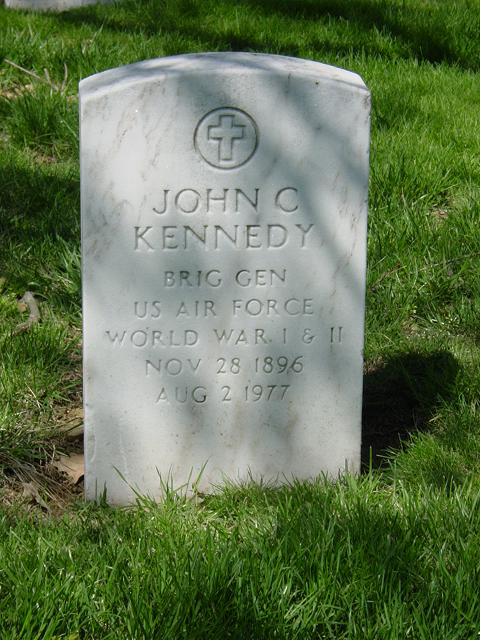Suggested By, And Gravesite Photo Courtesy Of Russell C. Jacobs, July 2007
Biography Courtesy of the United States Air Force
BRIGADIER GENERAL JOHN C. KENNEDY
Retired March 1, 1950. Died November 1, 1977.
John C. Kennedy was born in New York, New York, in 1893. He attended Fordham University, New York, after which he served as a Private First Class in the Signal Reserve Corps until August 15, 1917. On January 11, 1918, he was commissioned a First Lieutenant, Aviation Section, Officers’ Reserve Corps, and was promoted to Captain October 3, 1918. On July 1, 1920, he was commissioned a First Lieutenant in the Air Service of the Regular Army.
EFFECTIVE DATES OF PROMOTION
He was promoted to Captain October 1, 1930, to Major (temporary) June 16, 1936; to Major (permanent) June 12, 1939, to Lieutenant Colonel (temporary) June 25, 1940; to Lieutenant Colonel (permanent) October 15, 1941; to Colonel (permanent) Jan. 5, 1942; to Brigadier Beneral (temporary) January 8, 1945.
He spent the first three years of his service as commanding officer of the 27th, 12th, 22nd, and 186th Aero Squadron at Talliaferro, Texas, and Fort Worth, Texas, and with American Expeditionary Forces in France. Upon his return to the United States he became assistant chief, Operations Division, Training and Operations Group, Office Chief of Air Service, Washington, D.C., later serving as assistant chief of the Tactical Unit Section. In November 1921 he was assigned to instruct the Maryland National Guard at Logan Field, Md., and in May 1922 was assigned to Mitchel Field, Long Island, New York, as squadron armament officer, post school officer, and communications officer, later assuming command of the Air Intelligence Section.
In September 1925 he reported at Brooks Field, Texas, in command of the 47th School Squadron, later becoming senior instructor in the Department of Ground Inspection. In January 1929 he was assigned to foreign duty as squadron supply officer and squadron adjutant of the 66th Service Squadron at Nichols Field, Rizal, Philippines Islands, later performing the same duties with the 2nd Observation Squadron. In October 1930 he returned to the United States where he became post adjutant, custodian of the squadron fund, and later commanding officer of the 91st Observation Squadron and 15th Photo Section at Crissey Field, California. He remained there five years, and in July 1935 was transferred to Portland, Oregon, as control officer of Air Mail Route No. 5.
In July 1935 he assumed command of the 12th Observation Squadron, Brooks Field, Texas, and in June 1937 continued his duties in the same capacity at Fort Knox, Kentucky, having additional duties as squadron armament, gas, communications and operations officer. In September 1939 he was enrolled as a student at the Air Corps Tactical School, Maxwell Field, Alabama, and in September of the following year resumed his command of the 12th Observation Squadron, at the same time serving as chief of corps aviation with the I Armored Corps, air officer of the armed force, and military observer. During his tour of duty at that station he was placed on detached service as military observer in Washington, D.C., and later performed the same service in London, England.
In November 1941 he was named as commanding officer of the 73rd Observation Group, Godman Field, Kentucky, later becoming liaison officer, Headquarters and Headquarters Squadron, 9th Air Force, New Orleans Air Base, New Orleans, Louisiana. In May 1942 he was named commanding officer of the 77th Observation Group, commanding officer of the II and VIII Air Support Sub-command; and 77th Reconnaissance Group at Brownwood, Alamo Field, San Antonio and Abilene Texas; later transferring in the same capacity to Barksdale Field, Louisiana, where he became deputy commander of the II Air Support Command.
In September 1943 he was assigned to Headquarters and Headquarters Detachment, Chinese Training and Combat Command, Headquarters U.S. Army Forces in the China, Burma and India Theater of Operations, later assuming command of a composite wing in the same area.
He reverted to the rank of Colonel (temporary) January 31, 1946.
He is rated a command pilot, combat observer, aircraft observer, and technical observer.
Michael Robert Patterson was born in Arlington and is the son of a former officer of the US Army. So it was no wonder that sooner or later his interests drew him to American history and especially to American military history. Many of his articles can be found on renowned portals like the New York Times, Washingtonpost or Wikipedia.
Reviewed by: Michael Howard

